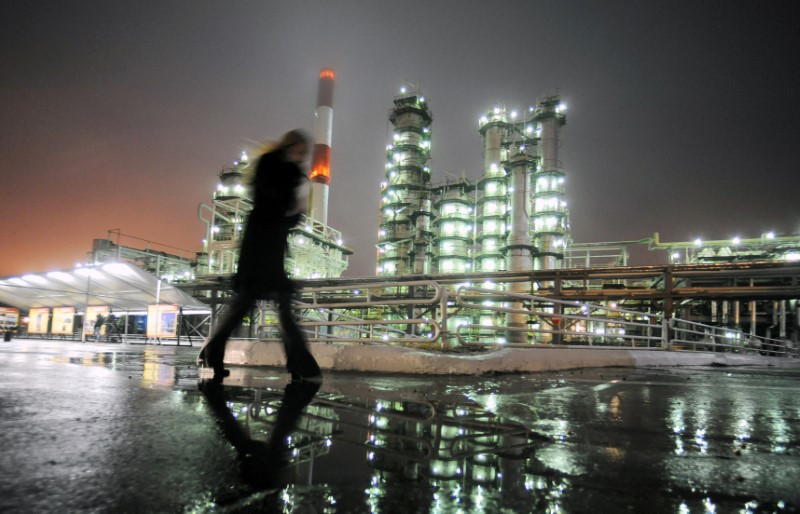Sanctions gap lets Western firms tap Russian frontier oil

OSLO/MOSCOW — A gap in U.S. sanctions allows Western companies to help Russia develop some of its most technically challenging oil reserves, and risks undermining the broad aim of the measures, a Reuters investigation has found.
When Washington imposed the sanctions on Moscow in 2014 over its annexation of Crimea and role in the Ukraine conflict, the U.S Treasury said it wanted to “impede Russia’s ability to develop so-called frontier or unconventional oil resources.”
The restrictions were designed to prevent Russia countering declining output from conventional wells by tapping these hard-to-recover reserves which require newer extraction techniques like fracking, an area where it relies on Western technology.
Three years on, however, Norway‘s Statoil is helping Kremlin oil giant Rosneft develop unconventional resources while British major BP is considering a similar project.
Statoil is not breaching sanctions, nor would BP be doing so.
The United States, having itself experienced a spike in oil output from tapping shale rock over the past decade, worded the measures to prohibit Western companies from helping Russia develop “shale reservoirs.” It did not mention other lesser-known forms of unconventional deposits.
The EU followed suit by banning cooperation on projects “located in shale formations by way of hydraulic fracturing.”
Rosneft and its Western partners are not targeting shale but are instead drilling to reach oil reserves known as limestone – deeper reservoirs that lie beneath shale oil.
Geologists are unanimous, though, that even though shale and limestone formations are different geological structures, they both constitute unconventional oil resources. Both are extracted through hydraulic fracturing, or fracking.
Experts say limestone deposits in Russia’s Domanik formation, where Statoil and Rosneft are drilling, could yield billions of barrels of crude.
Spokesmen for the U.S. Treasury, and for European Commission foreign affairs and security policy, both declined to comment on Russian projects, the wording of the sanctions or if any change was planned to include other unconventional oil resources.
STATOIL CHANGES WORDS
When Statoil and Rosneft agreed to develop 12 blocks in Russia’s Samara region in 2013, a year before the sanctions were imposed, they described the venture as a shale project.
Statoil, in media releases issued in June and December 2013, and its annual report for that year, said the venture would explore “shale oil” opportunities in the Samara region, which is situated on the Volga river.
After sanctions were imposed in 2014, the company amended all the releases on its website to replace “shale” with “limestone,” though it did not alter the 2013 annual report. It described the venture as limestone from that point on.
“In the original press release, and communication following that, we used an imprecise geological term,” a Statoil spokesman told Reuters. “We became attentive to this after the introduction of sanctions.”
“We have since corrected it, and now use the precise and correct term – limestone,” he added about the project, which saw its first well drilled in January this year.
“The Domanik formation is a limestone formation and is not covered by European or U.S. sanctions.”
Under EU sanctions, which Norway signed up to, companies have to ask for clearance from their governments to enter new Russian oil projects.
Statoil, which is majority owned by the Norwegian government, said it had “applied for and received a pre-authorization related to the Domanik project by the Norwegian Ministry of Foreign Affairs.”
Rosneft also started describing the venture as a limestone project after sanctions were imposed, but has not amended its previous statements which described it as shale.
“It would not be correct to call these sediments shale in the meaning of those being explored in the United States,” a Rosneft official told Reuters in emailed comments.
BP LOOKS TO EXPLORE
The Moscow Institute of Physics and Technology’s Center for Engineering and Technology for Hard-to-Recover Reserves estimates Russia’s Domanik oil deposits are around a tenth the size of the giant Bazhenov shale resources – which themselves could yield over 70 billion barrels of oil, according to the U.S. Energy Information Administration.
In May 2014, just months before the toughest sanctions were imposed on Russia, BP signed a similar agreement with Rosneft to explore in the Domanik formation in the region of Orenburg, about 400 km (250 miles) south east of Samara.
The project has yet to get off the ground but a BP spokesman in Russia said the company remained interested in exploring hard-to-extract resources in the Volga-Urals region.
He declined to comment further but a BP source said the company was currently seeking an approval from the British government to start work on the project.
The American shale revolution has seen U.S. firms flood the market with crude since the start of the decade – and Russian oil executives say their country could have shale and other unconventional resources as big as those in the United States.
Such deposits would allow Russia to maintain its output as production from mature, conventional fields in West Siberia is declining.
Additional reporting by Vladimir Soldatkin and Oksana Kobzeva in Moscow, Yeganeh Torbati in Washington and Gwladys Fouche in Oslo.